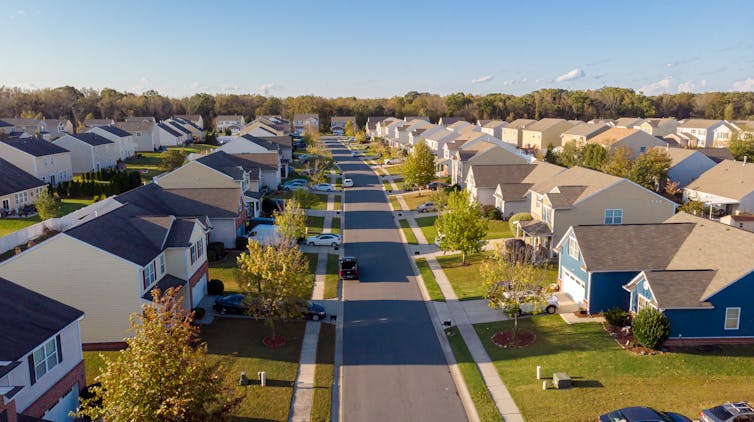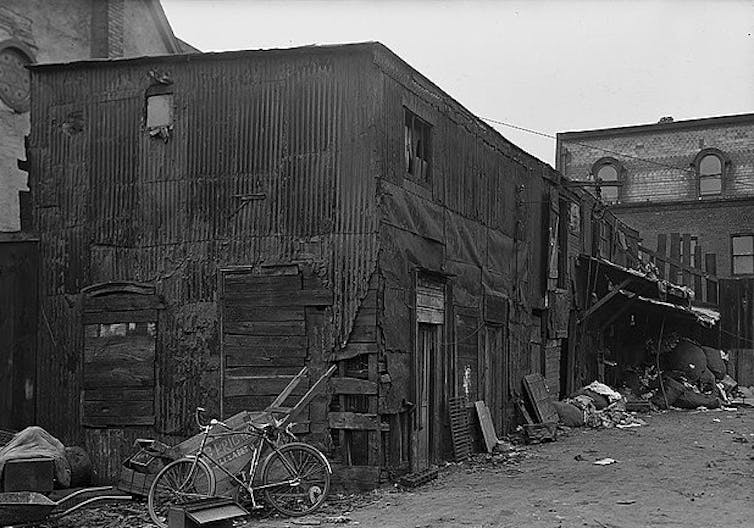Choices made nearly a century ago explain today’s housing crisis

Housing is an important political issue. Politicians and experts now talk about it as a major crisis that could threaten our economic and social well-being. But this is nothing new. Another housing crisis raged at the beginning of the 20th century.
Back then, it concerned working-class slums. Today, it’s much more widespread: many households are struggling to acquire property, while others are spending too much of their income on rent, and still others are living in substandard housing, or simply have nowhere to live.
As a specialist in the history of urban planning and a full professor at the Université de Montréal’s School of Urban Planning and Landscape Architecture, I hear arguments today that are similar to those made 120 years ago, although there are new elements now.

The promise of decent housing
As Roy Lubove has shown in The Progressives and the Slums, during the crusade against slums between 1890 and 1920, reformers on the right and on the left agreed in denouncing the greed of landlords who exploited vulnerable populations. Both called for measures that would give workers access to decent housing.
They also agreed that quality standards should apply to construction to ensure the health and safety of occupants, requirements such as minimum room volumes, minimum window sizes and minimum sanitary facilities. The question was, how to increase the quality of housing without making it too expensive for the average worker?
To this question, right-wing reformers replied that quality standards had to be increased gradually in function of the economic development and wage increases that capitalism was making possible. In response to socialism, they promised a constantly rising standard of living that would include steady improvements in housing quality standards.
Left-wing reformers wanted to ensure that housing production was not left up to market forces alone, and that the public and community (union) sectors would play an active role in ensuring this.
Domination of the private sector
In Canada and the United States, unlike in some European countries, the right won a crushing victory in this political battle. Although the state did build social housing at one time, and still offers subsidies to community groups, the private sector produces the bulk (no less than 97 per cent) of housing, sometimes with subsidies to builders and households.
As hoped at the beginning of the 20th century, there has been a consistent improvement in the quality of housing. The average size of new homes has grown steadily, although it now seems to have reached a plateau. Requirements in terms of comfort, safety and health have continued to rise. In addition to these standards, there are more and more requirements concerning the environmental and social impacts of new projects.
The conclusion is clear: given the choice between quality and affordability, we have made a societal choice in favour of quality. It’s a respectable choice, especially in terms of sustainability, but one that has a real impact on access to housing.
In response to the current crisis, the private sector needs to be encouraged to produce more affordable housing. Yet, at the same time, we need to reduce the dominance of the private sector. The profit-maximizing logic that drives it leads it to produce expensive housing and to contribute to the production of affordable housing only indirectly, through an inefficient “filtering” mechanism or through modest contributions imposed by certain municipalities.
However, producing affordable housing in the current circumstances is not an easy task. L'UTILE, an non-profit based in Montréal, offers affordable student housing by foregoing profits, focusing on density (high footprint and land-use coefficients), reducing the size of rooms and common spaces to a minimum, using prefabrication, and benefiting from substantial public subsidies (over $100,000 per three- or four-bedroom unit).
None of these strategies will be enough without government support. Given the very high cost of construction, even the middle class today needs support from the state.
Standards out of reach
In The City Below the Hill, published in 1897, reformer Herbert Ames denounced the deplorable living conditions of workers in Montréal and advocated for government involvement in housing. He hoped that, in time, every household would have a decent home, which he defined as:
… the ideal home is one where the front door is used by but one family, where the house faces upon a through street, where water-closet accommodation is provided, and where there are as many rooms allotted to a family as there are persons composing.
This ideal, updated for today’s standards, is still not within everyone’s reach. For households on the lowest incomes, it is becoming an increasingly remote possibility.
At the beginning of the 20th century, one could reasonably hope that capitalism would raise living standards and that the quality of housing would improve from one generation to the next. We now have to be realistic and accept the fact that the private market, alone, cannot meet the needs of part of the population. Of course, we need to increase housing production to better meet demand, but we also need to increase state aid, promote technological innovation to lower the cost of construction, and critically examine the accumulation of standards that apply to residential development.![]()
Raphaël Fischler, Professeur titulaire à l'École d'urbanisme et d'architecture de paysage, Université de Montréal
This article is republished from The Conversation under a Creative Commons license. Read the original article.
No comments:
Post a Comment